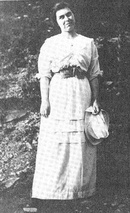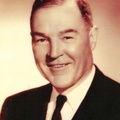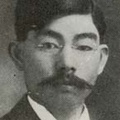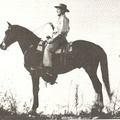Firehorses need exercise. For the youngsters on 15th Street in early Los Angeles, it was a thrill of a lifetime to sit on a big broad horse, legs astraddle, as the animal galloped up and down dusty Hill Street. Young boys were glad to “help” the firemen in this way. J. Marion Wright was one of these juvenile public servants. Although in later years as he drove down 15th Street he reflected upon the legalities and insurance aspects of such a wild activity, in the years around 1900 such matters were not on his mind.
What follows is a biographical sketch of J. Marion Wright, a Los Angeles pioneer and lawyer. His compassion and sense of justice led him to help California’s Japanese, aliens and United States citizens alike, to obtain their civil rights. Throughout his fifty-seven years as an active lawyer, his clients came from many backgrounds, but his most significant legal achievements were those involving Japanese clients between 1913 and 1952.
Marion was born in Los Angeles July 8, 1890. The city was just beginning the transition from a small town, known as “Queen of the Cow Counties,” to an active American city. The influx of Americans from the eastern states changed the character of the area within a short time. The Wright family was deeply involved in these changes.
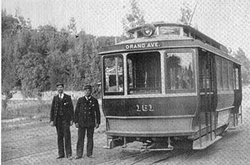
Edward L. Wright (on the left), Wright's father, was a motorman for the Los Angeles Rail Road. c. 1985.
Edward L. Wright, Marion’s father, came to Los Angeles from northern New York in 1888. He was a skilled tinsmith who learned upon arrival that there was no market for the tin church steeples which were his specialty. Jobs were scarce, and it was only after a year of searching that he found employment driving the horse-drawn street cars which furnished transportation in the City of Los Angeles. Mr. Wright became a motorman on the new trolley system when the horses were retired in about 1889.
Now that the family had a source of income, his wife, Ella Kingston Wright, was able at last to join him in burgeoning Los Angeles. The railroad trip from northern New York was arduous for Mrs. Wright and their two-year-old daughter, Nancy. The train was the most effective means of transportation, but it was completely devoid of comforts. The trip, which took six to seven days, was a jolting one characterized by coal dust, desert heat, insects, delays, and inadequate food. Because his original trip was so unpleasant Marion’s father, Edward Wright, refused to take the journey back to New York throughout his lifetime of ninety-nine years.
The family income was one of bare subsistence, and basic survival took all the thrift and ingenuity that the Wrights could muster. Marion and his two brothers were born in these ensuing years. There was a cow in the backyard, plus chickens and a vegetable garden. The descendant of one of the fig trees still exists and bears fruit a hundred years later.
In order to augment the family income, young Marion worked at many jobs. One employer taught him a lesson which he never forgot. He went to the beach one day instead of to his job in a bicycle shop. The needed job ended abruptly, and the young man learned at the age of fourteen the importance of responsibility. He later sold shoes and worked part time in a foundry. He spent some of his money on clothes, as he suffered acute embarrassment at the ill-fitting and made-over garment which he had to wear as a boy. In adult years, when he finally reached the height of six feet, two inches, the quality of the material of a suit, and above all, its fit, were of the utmost importance to him.
He entered Polytechnic High School, which at that time was on Pico Boulevard at the south end of Hope Street. This school stressed mechanical and manual training. After one year he transferred to Los Angeles High School atop Fort Moore Hill, the present location of the Los Angeles Board of Education. He came to realize that his skills and interests were not in the technical fields but in more verbal pursuits.
For years Marion wanted to be an engineer on a steam locomotive. After graduation he was persuaded by his brilliant and determined mother to enter the University of Southern California Law School. The tuition of $45.00 per semester was paid by a small but timely inheritance from a distant relative. It was prophetic that his father had named him Marion after a well-known lawyer who was a brilliant public speaker. The law was a good profession for young Mr. Wright, who passed the State Bar examination July 19, 1912 before he graduated from law school. He studied hard but had time to play on the small but enthusiastic Law School basketball team in 1911–1912. He received practical training as a law clerk in the office of George B. Beebe, and his partner, Fred A. Stephenson. He worked with these men both before and after he passed the bar. After graduation legal pursuits kept him busy ten to twelve hours a day, six days a week.
The Third Presbyterian Church on Adams St. was the place of worship for the family. Marion was active in the church in boyhood and continued his participation in this and other churches throughout life. Some of his early activities were less than helpful, such as the occasion on which he and another mischievous friend raided the supply of Christmas candy, which was set aside for a mission project. In his teens he was active in a youth group, Christian Endeavor, and served as its county president in his late teen years. The first sight of Marion by his future wife, Alice, was at a Sunday church service. Although he had a broken leg at the time, he was lustily leading the group singing with his cane. He was then sixteen years old, Alice was twelve.
Their first “date” reflected the further growth of the transportation system in Southern California. It was a well-chaperoned, daylong trip in January 1912 on the Pacific Electric “Big Fed Cars.” The car tracks at that time made a circle from Main Street in downtown Los Angeles to Redondo Beach and back. This trip was known as the balloon excursion and was very popular with young people. Marion and Alice were married on November 25, 1916. Their happy union endured for fifty-three years.
* “J. Marion Wright: Los Angeles’ Patient Crusader, 1890–1970” by Janice Marion Wright La Moree was first published in Volume 62, no. 1 (Spring 1990) of the Southern California Quarterly, then reprinted separately in a limited edition that same year.
**All photographs are courtesy of the author
© 1990 Janice Marion Wright LaMoree



